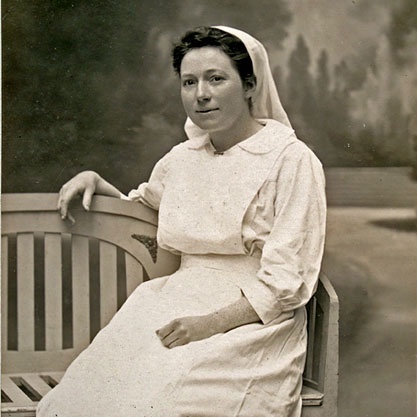
Amelia attended lectures provided by the Red Cross to encourage women into the nursing profession during the war. After passing her exams, at the top of the class, she was encouraged by a family friend, Dr Brock, to study anatomy and he offered to obtain her a position as a nurse, which she declined preferring to concentrate on her musical studies.
Despite her rejection of a nursing post she states in her later letters her interest in studying the rehabilitative benefits of massage. Amelia took lessons in massage from a Swedish masseuse, who attended her church, and continued her study of anatomy. She then devoted herself to finding a position as a masseuse in a military hospital.
During her first post at Aix-le-Bains in France, Amelia was given relative freedom in her role as masseuse. She felt that the doctors did not understand the benefits of massage and believed it was a novelty. By the end of her stay, Amelia’s work had impressed the doctor and she supervised her own staff.
Amelia returned to Rome and began working in a local hospital as a nurse, which she disliked due to the poor conditions, particularly the lack of cleanliness. She did not like nursing as much as massage and finally left the hospital after she discovered a doctor using a nurse’s wash hand basin as a toilet ‘without even locking the door!’
Amelia went back to France, but she spent months between positions trying to secure more work, battling red tape and negative attitudes towards massage. Between hospital work she experimented with methods of splinting broken bones, using newspaper strips, sacking and linseed oil or paper glued with starch in water. She also created cork soles for the shoes of soldiers who had shortened legs due to war injuries and prosthetics for missing limbs.
What becomes very clear from her letters is how grateful her patients were to her. She received an autograph book signed by all the staff and patients at Chambéry, and was affectionately known as ‘petite maman’ by patients. Her care and affection for her patients is obvious by her descriptions of their injuries and treatment alongside colourful accounts of their characters and backgrounds.
Amelia continued to work in France after the war until December 1920 when she decided to return to Scotland. Her experiences in France and Italy lead her to enrol in medicine at the University of Edinburgh in 1925, where she qualified as a doctor in 1930.
To read edited extracts from this rich collection of letters please see our catalogue MS 3290/2.
Image of Amelia Nyasa Laws © National Museums Scotland
